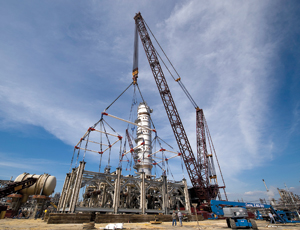The typically methodical nature of oil and gas facility development could not fully insulate the sector’s construction activity from the economic roller coaster of the past 12 months, which saw commodity prices for crude oil skyrocket to $140 a barrel, than plummet just as quickly to the low $30s as motorists and industries around the world slashed consumption.


“The market downturn and financial crisis curbed everything,” says Peter Stalenhoef, president and COO of PCL Constructors Inc.’s heavy industrial business.
A sudden slowdown of activity at Alberta’s vast oilsands deposits—North America’s go-to region for petroleum development over the past several years—illustrates the depth and suddenness of the sector’s slowdown. Several major projects, such as Suncor Energy’s $18.6-billion expansion and Statoil Hydro’s $14.5-billion upgrade have been halted while Royal Dutch Shell has postponed expansion of its Athabasca oilsands project.
“The recession affected Alberta very quickly,” says Jim Jackson, president of Bechtel’s Houston-based oil, gas and chemicals business unit. “Customers reexamined their projects and capital investments, and saw they wouldn’t have the capital to keep moving at the same pace.”
One oilsands-related project that remained on track is the $12-billion, 2,148-mile-long Keystone Pipeline, a partnership of TransCanada and ConocoPhilips that will transport 590,000 barrels of oil daily from Calgary to refineries in Illinois and Oklahoma. Bechtel is providing engineering and construction-management services for the Keystone and the Keystone XL extension to Texas Gulf Coast refineries.
Although crude oil prices have gradually edged upward to the $70-per-barrel mark since the start of 2009, a sluggish long-term demand outlook could constrain the sector’s comeback. In late July, the Canadian Association of Petroleum Producers predicted oilsands output for the next decade will grow from 2008’s total of 1.2 million barrels per day to 2.9 million bpd in 2020, a 600,000-bpd reduction from what the association forecast a year ago.
Worldwide, the outlook for petroleum demand is mixed. The International Energy Agency forecasts a 1.7% increase in global oil consumption for 2010, while the Organization of Petroleum Exporting Countries (OPEC) predicts a more modest .5% rise. OPEC also expects consumption among members of the Organization of Economic Development and Cooperation, which includes the U.S. and Canada, to drop 1% in 2010, to 45.5 million bpd, and remain at that level through 2013.
Despite the uncertain outlook, Stalenhoef says the sector’s contractors should have little difficulty remaining busy.
“The demand for oil will continue to spur investment,” he says. “The Suncor expansion project will certainly resume, as they’ve already bought the equipment and done site prep.”
“Things are still pretty active,” agrees Michael Collier, vice president for investor relations, sales and marketing for Willbros Group Inc., Houston, which will construct pump stations for the Keystone Pipeline. “We expect...



Post a comment to this article
Report Abusive Comment